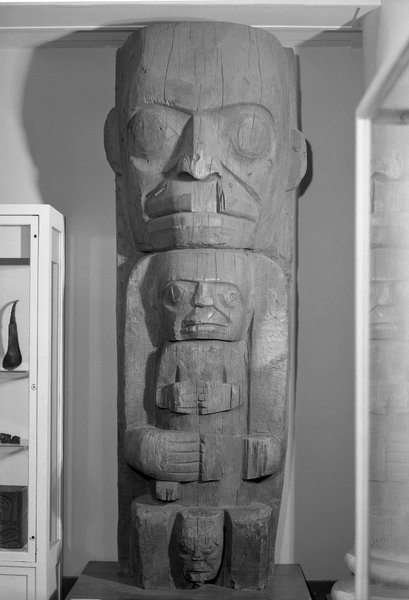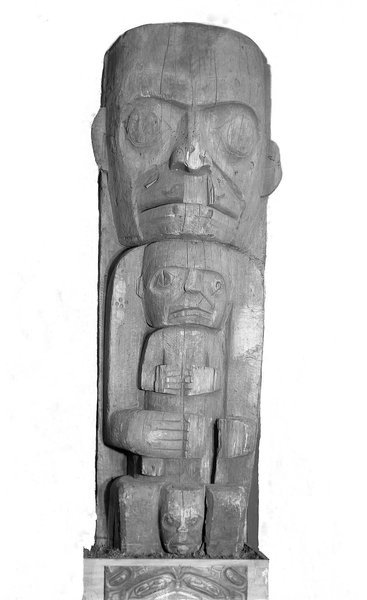House Post, from a Set of Four Item Number: 11.700.4 from the Brooklyn Museum


Description
The object is a house post made of cedar wood, dark and unpainted. Two figures include a large humanoid figure holding a small humanoid figure. The small figure is held in front of the larger figure's chest area. Each head has carved brows, eyes, ears, nose, and mouth. There is also a small humanoid head with carved features between the knees of the larger figure. Frontal figures and head are carved in high relief. Back is roughly carved and relatively flat. House post is fragile. There are cracks throughout. There are exceptional losses of wood on and behind small head at bottom. There are miscellaneous holes, especially on the nose of the larger figure. Missing parts include a portion of the left hand and upper lip of the large figure as well as the left foot of the small figure. The back of larger figure's head is hollowed out. The post is very fibrous along the edge of the bottom. This house post is from a set of four (see 11.700.1-.2-.3).
Credit Line
Museum Expedition 1911, Museum Collection Fund
Label
The two house posts seen here and owned by the Heiltsuk eagle clan of Yálátli (Goose Island) depict the following creation story. In the beginning of time, many inhabitants of the land were animals and supernatural creatures. Some could take off their fur and feathers and assume human shape, while others remained in their supernatural form. One day a supernatural eagle, with the face of a man and an eagle’s beak, saw a whale in the water and seized it for his food. After a mighty struggle the eagle flipped the whale over and began to devour it, spilling the whale’s intestines into the water, where they became Yálátli Island. The eagle decided to live on this island, becoming human and taking the name Wígvilhba (Eagle-nose), which was passed down through generations to the Wígvilhba Wákas Chieftainship, today held by Chief Harvey Humchitt.
Estos dos pilares de casa, propiedad del clan águila Heiltsuk de Yálátli (Isla Ganso), presentan la siguiente historia de creación. En el comienzo de los tiempos, muchos habitantes de la tierra eran animales y criaturas sobrenaturales. Algunos podían sacarse la piel y plumas y asumir forma humana, en tanto otros permanecían en su forma sobrenatural. Un día, un águila sobrenatural con la cara de un hombre y pico de águila, vio una ballena en el agua y la atacó para comérsela. Después de una lucha poderosa, el águila volteó a la ballena y comenzó a devorarla, derramando sus intestinos en el agua, donde se convirtieron en la Isla Yálátli. El águila decidió vivir en esta isla, volviéndose humano y tomando el nombre Wígvilhba (Nariz de Aguila), el cual fue heredado por generaciones por la jefatura Wígvilhba Wákas, hoy llevada por el Jefe Harvey Humchitt.
Item History
- Made between 1800 and 1899
What
- Name
- House Post, from a Set of Four
- Identification Number
- 11.700.4
- Type of Item
- house post, four and set
- Material
- cedar wood
- Overall
- length 105.75 in, width 32.75 in, height 21.0 in
Who
- Culture
- Heiltsuk
Where
- Holding Institution
- Brooklyn Museum
When
- Creation Date
- between 1800 and 1899
Other
- Location
- Arts of the Americas Galleries, 5th Floor
- Classification
- (not assigned)